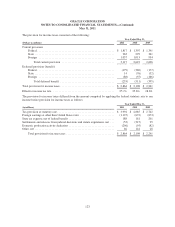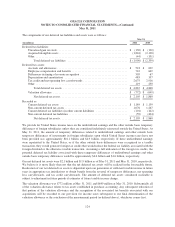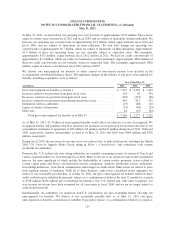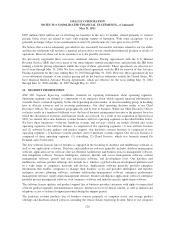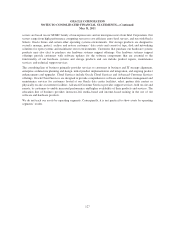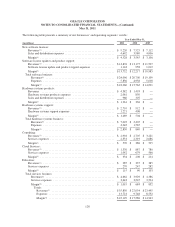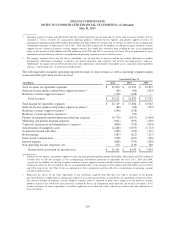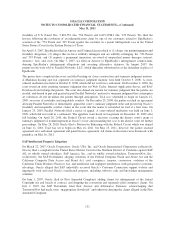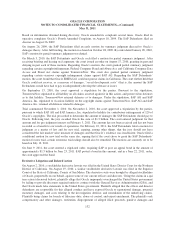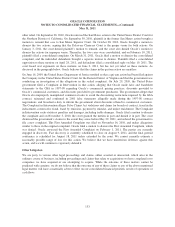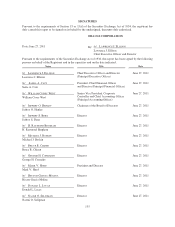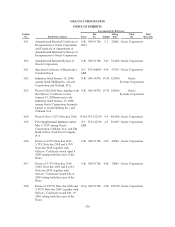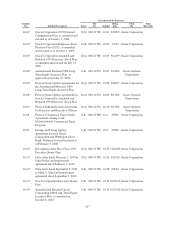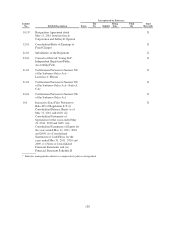Oracle 2011 Annual Report Download - page 134
Download and view the complete annual report
Please find page 134 of the 2011 Oracle annual report below. You can navigate through the pages in the report by either clicking on the pages listed below, or by using the keyword search tool below to find specific information within the annual report.ORACLE CORPORATION
NOTES TO CONSOLIDATED FINANCIAL STATEMENTS—(Continued)
May 31, 2011
Based on information obtained during discovery, Oracle amended its complaint several times. Oracle filed its
operative complaint, Oracle’s Fourth Amended Complaint, on August 18, 2009. The SAP Defendants filed an
Answer on August 26, 2009.
On August 26, 2009, the SAP Defendants filed an early motion for summary judgment directed to Oracle’s
damages theory. After full briefing, the motion was heard on October 28, 2009. By order dated January 28, 2010,
SAP’s motion for partial summary judgment was denied.
On March 3, 2010, the SAP Defendants and Oracle each filed a motion for partial summary judgment. After
receiving briefing and hearing oral argument, the court issued an order on August 17, 2010, granting in part and
denying in part each of these motions. Regarding Oracle’s motion, the court granted partial summary judgment
regarding certain copyright infringement, Federal Computer Fraud and Abuse Act, and California Computer Data
Access and Fraud Act claims against TomorrowNow. The court also granted partial summary judgment
regarding certain vicarious copyright infringement claims against SAP AG. Regarding the SAP Defendants’
motion, the court found that Oracle EMEA Ltd. could not pursue claims in California. The court further held that
Oracle could not recover, as a measure of damages, “saved development costs” (that is, the amount the SAP
Defendants would have had to pay to independently develop the software at issue).
On September 13, 2010, the court approved a stipulation by the parties. Pursuant to the stipulation,
TomorrowNow stipulated to all liability on all claims asserted against it in this action, and preserved no defenses
as to that liability. TomorrowNow retained defenses as to damages. Under the stipulation, SAP AG and SAP
America, Inc. stipulated to vicarious liability on the copyright claims against TomorrowNow. SAP AG and SAP
America, Inc. retained all defenses related to damages.
Trial commenced November 1, 2010. On November 2, 2010, the court approved a stipulation by the parties,
pursuant to which SAP AG and SAP America, Inc. stipulated to liability for contributory infringement of 120 of
Oracle’s copyrights. The trial proceeded to determine the amount of damages the SAP Defendants should pay to
Oracle. Following trial, the jury awarded Oracle the sum of $1.3 billion. The court entered judgment for that
amount and for pre-judgment interest on February 3, 2011. The amount has not been received and has not been
recorded as a benefit to our results of operations. On February 23, 2011, the SAP Defendants filed a motion for
judgment as a matter of law and for new trial, arguing, among other things, that the jury should not have
considered the fair market value measure of damages and that Oracle’s evidence was insufficient. Oracle filed a
conditional motion for new trial on the same day, arguing that if the court chose to grant the SAP Defendants’
motion for new trial, certain erroneous trial rulings should also be remedied. The motions are currently set to be
heard on July 13, 2011.
On June 9, 2011, the court entered a stipulated order, requiring SAP to post an appeal bond in the amount of
approximately $1.3 billion by June 23, 2011. SAP posted a bond in this amount, and in a June 22, 2011, order,
the court approved the bond.
Derivative Litigation and Related Action
On August 2, 2010, a stockholder derivative lawsuit was filed in the United States District Court for the Northern
District of California. On August 19, 2010, a similar stockholder derivative lawsuit was filed in the Superior
Court of the State of California, County of San Mateo. The derivative suits were brought by alleged stockholders
of Oracle, purportedly on our behalf, against some of our current officers and directors. Citing the claims in a qui
tam action (discussed below), plaintiffs allege that Oracle improperly overcharged the United States government
by failing to provide discounts required under its contract with the General Services Administration (GSA), and
that Oracle made false statements to the United States government. Plaintiffs alleged that the officer and director
defendants are responsible for this alleged conduct and have exposed Oracle to reputational damage, potential
monetary damages, and costs relating to the investigation, defense, and remediation of the underlying claims.
Plaintiffs bring claims for breach of fiduciary duty, abuse of control, and unjust enrichment. The plaintiffs seek
compensatory and other damages, restitution, disgorgement of alleged illicit proceeds, punitive damages and
132



